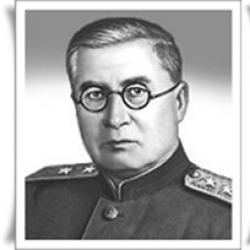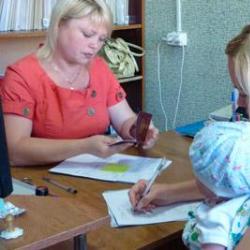Exhibition “Siberians, free and involuntary. The two-volume book “Unwitting Siberians, Free and Unwitting Siberians Chigrina” was presented at the Pushkin Library
We've answered the most popular questions - check, maybe we've answered yours too?
- We are a cultural institution and want to broadcast on the Kultura.RF portal. Where should we go?
- How to propose an event to the portal’s “Poster”?
- I found an error in a publication on the portal. How to tell the editors?
I subscribed to push notifications, but the offer appears every day
We use cookies on the portal to remember your visits. If cookies are deleted, the subscription offer will pop up again. Open your browser settings and make sure that the “Delete cookies” option is not marked “Delete every time you exit the browser.”
I want to be the first to know about new materials and projects of the portal “Culture.RF”
If you have an idea for broadcasting, but do not have the technical ability to carry it out, we suggest filling out an electronic application form within the framework of the national project “Culture”: . If the event is scheduled between September 1 and November 30, 2019, the application can be submitted from June 28 to July 28, 2019 (inclusive). The selection of events that will receive support is carried out by an expert commission of the Ministry of Culture of the Russian Federation.
Our museum (institution) is not on the portal. How to add it?
You can add an institution to the portal using the “Unified Information Space in the Field of Culture” system: . Join it and add your places and events in accordance with. After checking by the moderator, information about the institution will appear on the Kultura.RF portal.
The Urmancheev family lives in the village of Timiryazevo. Over the 64 years of marriage, Nalia Ramazanovna and Anvar Abdulganeevich raised three daughters, became happy grandparents of 5 grandchildren, who later gave them 10 great-grandchildren, between them they devoted 80 years to their favorite teaching work and preserved the history of their family.
Our meeting took place within the framework of the project of the Tomsk Regional Museum of Local Lore. M.B. Shatilov "Siberians, free or involuntary." The project was invented by local historians in 2013. During this time, “Free or Involuntary Siberians” collected many stories of migrants whose lives were connected with Siberia.

The head of the family, Urmancheev Anvar Abdulganeevich, was born in 1928 in the village of Novo-Islambul (Krivosheinsky district, Tomsk region). His grandfather was among the founders of this village.
— My maternal grandfather was a mullah. Together with his family, he came to Siberia from near Kazan. The move took place as part of the Stolypin reform in 1908. My grandfather was among the founders of the Tatar village of New Islambul. The name spoke for itself. The village residents professed Islam. Before that, in his native Tatar land, he worked at the Bandyuzhsky Metallurgical Plant (the oldest Russian chemical industry plant, where Dmitry Mendeleev once worked). A difficult life prompted them to move to Siberia. They traveled on carts and lived in huts. My mother was only 8-9 months old at the time of the move.
From 1945 to 1950 Anvar Urmancheev studied at the Tomsk Tatar Pedagogical School (now Tomsk Pedagogical College), where he met his future wife, 2nd year student Nalia. A geographer by training, he later also taught history, mathematics, chemistry, physics, labor and physical education - there were not enough teachers in rural schools. First, after graduating from college, I went to the Krasnoyarsk Territory as assigned. But I never had time to work there. A summons arrived from the army. He served in the navy in the Far East. After the service, he was sent to the Elga seven-year school (Krasnoyarsk Territory), where at that time his fiancée, Nalia, worked as a teacher of Russian language and literature.
The peculiarity of these schools was that they were located in Tatar villages, and the population practically did not speak Russian.
“At first we explained the educational material to the students in Russian,” explains Anvar. — Then in Tatar, and they asked the children in Russian.
— When I was at school, I also spoke Russian poorly. The teacher allowed us to answer in writing. It was easier to write than to speak. In the Tatar pedagogical school we were given the same knowledge as in the Russian one. But our program was specific: we studied, for example, Tatar poets: Toktash, Tukay,” Nalia shares her memories.
— We also had the opportunity to work in Russian rural schools. The students called me Alexei Alexandrovich, and Nalia - Nellei, this was the custom in the Soviet Union; they explained to us that our Tatar names would be difficult for Russian children to pronounce,” adds Anvar.
A Siberian with Kazan roots, Nalia Ramazanovna was born in 1931 into a family in the village of Yurty-Konstantinovy in the Tomsk region. She had two brothers.
“Dad was a veterinarian-paramedic in the neighboring Kemerovo region, mother took care of the house: milked cows, and took care of our upbringing.
For their time, Nalia's parents were quite educated. Her father studied at a madrasah in Yurga and knew 4 languages: Arabic, Latin, Tatar and Russian.
“As children, we didn’t sit idle either. I have been mowing hay since I was 12 years old. They carried the drag (cart) on themselves. They felled two birch trees - they were shafts. They placed one across them. Hay or stacks of grain were piled on top. In a word, they worked and did not know the word laziness.
Nalia worked as a teacher of Russian language and literature at the Tatar Elgin seven-year school, at the school in the village of Suchkovo (all in the Krasnoyarsk Territory), then, after returning to the Tomsk region: at Russian schools in the villages of Semiluzhki and Timiryazevo. Constant moving from one village to another was explained to them by the shortage of teachers and the desire of the state to eliminate illiteracy.
The Urmancheevs remember with emotion their relatives whose lives were cut short during the Great Patriotic War.
After his return from the Finnish War, Nalia's father went to the front again.
In the village in which they lived at that time, Yurt Konstantinov, they equipped a barge on which he and other fellow villagers were taken to Tomsk. Nalia, who was 9 years old at that time, remembers seeing her father off from Tomsk. She remembers the barracks on the Irkutsk Highway, how her father treated her to dry rations. Then he and other men were put on carts and taken to the Tomsk-II railway station.
“My uncle also went to the front with my dad. Letters remained from the brothers who disappeared in battle. The father wrote to his wife in Arabic, and his brother wrote to the family in Tatar (using the Latin alphabet). They did not write about battles and war; it was forbidden. They reported that they were alive and well, and conveyed greetings and wishes to their loved ones,” says Nalia.

Anvar’s father also died in the village of Pogostino, Liozno district, Vitebsk region. Later, the family was informed that Soviet soldiers were buried near a rural school.
After telling the story of their family, Anwar and Nalia began talking about their children and grandchildren and the current traditions of the family.
— Despite the fact that our grandchildren mostly speak Russian, we respect traditions. When grandson Ravil married a Russian girl, she converted to Islam.
Remembering their youth, the Urmancheevs say that, like all party people, they were atheists.
— National holidays were celebrated, but fasting (a 30-day fast) was not observed in Soviet times. If they believed, it was in secret. We even had a wedding without a mullah or national clothes. The bride wore a crepe georgette dress, the groom wore a sailor's uniform. Nikah (Muslim marriage ceremony) was also not performed.
But Kurban Bayram was celebrated.
“My grandmother said that in honor of the holiday the ram should be slaughtered by the eldest. Before her death, she bequeathed to us to invite a mullah to perform the ceremony.
When asked whether their family speaks their native Tatar language, the Urmancheevs replied that, unfortunately, they mostly speak Russian, but without changing traditions, at dinner they thank each other “Rakhmat” (thank you) and wish “Isan” bul-isәn bulygyz” (be healthy).
At the end of the meeting, the Urmancheevs taught me how to say hello and goodbye in Tatar. So, goodbye. Sau bulygyz!
» - project of the To-ms-ko-go region-of-the-wed-ches-ko-go museum named after. M.B. Sha-ti-lo-wa. For-da-cha pro-ek-ta - “gather together as many ma-te-ri-a-lovs for the problem of for-mi-ro-va-niya on -s-e-le-niya Si-bi-ri and Dal-ne-go Vos-ka.” The site has been running since 2014.
In 2014, TOKM named after M.B. Sha-ti-lo-va pre-ds-ta-vil project for the grand-to-vy con-ku-rs Bla-go-tvo-ri-tel-no-go background-da Vla-di-mi- ra Po-ta-ni-na. The idea of the pro-e-ta is to look at the history of the island of Siberia through the personal stories of people. For this purpose, it would be possible to create a website on which any citizen could do business with it, use it send fact-ti-che-s-kiy ma-te-ri-al about your family. For “Sto-ly-pi-ns-ko-go” re-ri-o-da would-be-for-pla-ni-ro-va-na inter-active-tiv-naya you-stav-ka with re-ko-nstruk-tsi-ey.
For-da-chi kli-en-ta
The client solved several problems:
- give people a simple and convenient interface for adding to their is- tions: a person should go to bed -to add photo-graphics, those-ks-you, do-ku-men-you;
- The museum's co-operators must mo-de-ri-ro-tall all the necessary is-to-ries and arrange them according to the definition -th pra-vi-lam;
- storing a complete history of all useful data;
- on the site you need a card, ak-tu-al-naya for every is-to-ri-che-s-ki-period: per-s-e-ti-tel dol- wives see the borders of the gubernia, districts, regions;
- all the information on the website, including cartography, should be up-to-date on the “mobile station” even then, when there is no inter-ter-that;
- the site should work with a large volume of information, maintain high loads;
- the site should have a reserve according to the technical decision for several years - the client does not pay for it -to spend funds on up-dates and carry funds for fashionable technologies.
Solution
The main thing on the site is the stories of people. We needed to think about the or-ga-ni-za-tion of the pro-tse-s-sa for-pol-ne-niya say-ta is-to-ri-ya-mi. From po-s-e-ti-te-la say-ta tre-bu-e-tsya mi-ni-mum dey-st-viy and qual-li-fi-ka-tion: you need to pay the thread is six-fold. After the search, it is placed in the database and a unique link is created for it. In Si-s-te-me Admi-ni-st-ri-ro-va-niya mo-de-ra-tor-is-to-rik sees is-to-riu and na-chi-na-et work with her: fill in the full details, check with the author for information and then pub-li-ku-et.
The site was managed using our own Adx CMS solution. Re-a-li-za-tion project pro-ho-di-la according to the ot-ra-bo-tan-noy pro-tse-du-re:
- is-s-le-do-va-niya and po-i-sk decision
- about-ti-pi-ro-va-nie and design
- site development
- testing
- let's get ready
- za-pu-sk
The site has two blocks “Is-to-rii” and “Bib-lio-te-ka”. If Is-to-rii are is-to-rii and po-i-sk according to various filters, then Bib-lio-te-ka are official do-ku -men-you.
The greatest difficulty of this pro-ek-ta is the is- ing of car-tography offline. The site should be fully ac-tua-len on a mobile platform, working offline.
We couldn’t use the online maps of Yandex or Google - they won’t be up to date without the internet. That’s why, to solve the problem with the card, you need the open (Open Source) Leaflet engine, which is positioned in the hand work with cards. We are outside the data (villages, counties, districts, regions of To-ms-koy gub-ber-nii) according to several sources ri-che-s-kim pe-ri-o-dam.
When the mobile device is working, the ak-tu-al-naya adapt-ti-ro-van-naya ver-rs-iya site is do-s-tup-na-s -e-ti-te-lam na huge TV-video with ta-ch-kri-n. Syn-chro-ni-za-tion of data about-and-s-ho-dits when there is do-s-tu-pa on the Internet.
Technologies
With the choice of tech-no-lo-gi-ches-ko-go-she-she-tion, we decided for-da-chi without-danger-but-with-ti, high-at- loads and you'll just be supported. It is impossible to use new technologies - the client will not be able to invest funds in the new updated ones. Niya say-ta. As a result, you bra-whether:
- Operating systems: Linux on the main server, Windows on the computer;
- Layout: HTML, CSS, LESS, BEM;
- Front-end: JavaScript, jQuery, Leaflet;
- Si-s-te-we con-tro-la ver-rs-y: Git;
- Programming languages: PHP;
- Databases: MySQL.
The site is located in the region of To-ms-ko-kra-e-ved-ches-ko-go-museum, providing There is a daily backup of data.
Summary
The site looks modern on the outside and technologically advanced on the inside: the site can be expanded in terms of volume of content when not installed -vii of the client's expenses for our services.
The total time from the first meeting to the end of the day is 7 months. “What” time (the time when we worked on the project) - 14 weeks:
- General ar-hi-tek-tu-ra - several days;
- Pro-to-ti-pi-ro-va-nie - 1 week;
- Design - 3 weeks;
- Time-to-work - 8 weeks;
- For-pu-sk and use-of-those-with-ti-ro-va-nie - 1 week.
Re-zul-ta-you kli-en-ta
The project “Si-bi-rya-ki, free and involuntary” has become a be-di-te-lem grand of the con-kurs “Me-nya-yu-shiy- Xia museum in my world" 2013 in no-mi-na-tion "Management of in-no-va-tsi-mi in mu- zey prak-ti-ke”, and then was recognized as one of the best re-a-li-zo-van-projects of 2013/2014.
In 2016, the website of the me-mo-ri-al-no-go pro-ek-ta “Ci-bi-rya-ki free and involuntary” became a be-di-te-lem of the All- e-ro-s-s-iis-ko-ku-rsa "Positive content-2016" in the nomination "Best media-re- s-urs.”
The museum actively develops the project and tries new forms, such as:
- theat-ral-on-the-right performance “Cha-i-ns-some vo-s-s-ta-nie”;
- a very big game about the history of the re-s-e-le-niy in To-ms-ku-gu-ber-nia “from Ro-s-s-ei to Si- bir."
Customer review
Shirko A.N., Deputy Director of TOKM named after. B.M. Shatilova.
On the Day of Memory and Sorrow, June 22, the Omsk State Regional Scientific Library named after A. S. Pushkin hosted a presentation of a unique edition of the memorable series “Involuntary Siberians”. The book is prepared by the editors « Books of Memory of Victims of Political Repression" and dedicated to the Germans and Kalmyks deported to the Omsk region from the western regions of the country.
- “Involuntary Siberians” - the third cycle of the Book of Memory. The first - “Not subject to oblivion” - was dedicated to the 32 thousand residents of the Omsk region who suffered under the “political” 58th article of the Criminal Code of the RSFSR. At an international conference in St. Petersburg, the cycle was recognized as the best in the country. The second cycle - “Peasant Golgotha” - includes five volumes that contain information about 17.5 thousand dispossessed and exiled heads of peasant families, - editor-in-chief reported Maria Sbitneva.
"Involuntary Siberians" became part of a large-scale project " Book of Memory of Victims of Political Repression" . Since 2000, a total of more than a dozen volumes have been published, among which the three-volume volume stands out for its uniqueness and the enormity of the work done. Peasant Calvary" . Each volume is based on the meticulous work of the editors with a whole array of documents.
The first volume of the book is presented in paper form; its circulation was 650 copies. The book was received by all libraries in the region, archives, and museums; 400 copies were transferred to Pushkinka. The book includes biograms of 16 thousand heads of families of German and Kalmyk nationality, deported to the Omsk region during the Great Patriotic War. For the most part, they were deported as whole families, with young children and the elderly. Therefore, each biogram contains up to ten or more names, mostly children's. The book also includes materials and numerous documents of that period, memories, photographs, and essays. Among the authors of the volume are scientists, writers, journalists, descendants of those who were deported to our region.
The second volume is presented in electronic form on disk. It was prepared with the assistance of the information center of the Russian Ministry of Internal Affairs for the Omsk region.
“The Book of Memory is a historical phenomenon for the Omsk region. A tremendous amount of creative and analytical work was done. Many thanks to the editorial team. Unique data that will be in demand has been collected. The issue is now being considered to invite the editors to continue their work and publish the book in electronic form. This will allow the Book of Memory to be replicated on a large scale, and young people will be able to familiarize themselves with it en masse. I think the Book of Memory will get a second wind,”- said the head of the Main Directorate of Information Policy of the Omsk Region Stanislav Sumarokov.
Participated in the presentation historians, local historians, representatives of archives and museums of the region.
The history of Russia in the 20th century is currently causing heated discussions, splitting Russian society and distracting people from solving pressing problems. Realizing the role of the museum as an active popularizer of history among the population and the need to consider the Russian past “without anger or partiality,” the museum sees the main idea of the project as posing for society to understand the problem of the two greatest waves of migration of the first half of the twentieth century: the resettlement movement within the framework of the agrarian reform of P.A. Stolypin and forced relocation to the northern regions of the region as part of the repressive policy of I.V. Stalin.
The social and cultural space of the Tomsk region (province) was and is being formed as a result of large-scale migration processes. Some of the most significant ones occurred in the first half of the 20th century. We are talking about the voluntary resettlement of peasants to the southern regions of the Tomsk province (Siberia) from the European provinces of Russia in 1906-1914. as part of the Stolypin agrarian reform, as well as about the forced movement, starting in the 1920s, of special settlers to the northern regions of the region during the implementation of Stalin’s repressive policies. A significant part of the current residents of the Tomsk region are descendants or relatives of these free and involuntary migrants. At the same time, perceiving the family as one of their key values, proud of their status as a “Siberian,” modern Tomsk residents for the most part have little knowledge of the history of their family, the heroic and tragic pages of the history of their Small Motherland and Big Motherland, and rarely use this historical experience when solving current problems. present moment of individual and generally significant problems.
Based on this, the project involves the creation and promotion of a mobile exhibition. It will consist of: 1) a prefabricated and transformable copy of the “Stolypin carriage”, 2) original and replica museum objects, 3) multimedia equipment that allows not only to demonstrate a variety of visual materials, but also to enhance the attractive effect of the exhibition (create the illusion of movement, reproduce the “landscape” outside the carriage windows) and 4) the museum website associated with the exhibition. The presented exhibition complex will allow residents of the Tomsk region and other interested parties to recreate, publish and discuss their local family stories related to the broader social and cultural context - the Stolypin reform and Stalinist repressions, as well as the history of Russian society in the 20th century as a whole. This is necessary for: a) understanding your individual (your family) place and role in large-scale historical events, the complexity and ambiguity of historical events and their subsequent interpretations, b) a visual representation of the methods and results of state policy for the development of the Siberian region in modern times, c) choosing, based on historical experience, positive and beneficial behavioral strategies for people and society during a period of rapid social change.





